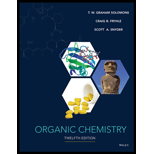
Interpretation:
The outcome of the reaction of tert-pentylchloride with propene and its mechanistic steps are to be predicted.
Concept introduction:
Electrophiles are electron-deficient species, which has positive or partially positive charge. Lewis acids are electrophiles, which accept electron pair.
Nucleophiles are electron-rich species, which has negative or partially negative charge. Lewis bases are nucleophiles, which donate electron pair.
Substitution reaction: A reaction in which one of the hydrogen atoms of a hydrocarbon or a
Elimination reaction: A reaction in which two substituent groups are detached and a double bond is formed is called elimination reaction.
Addition reaction: It is the reaction in which unsaturated bonds are converted to saturated molecules by the addition of molecules.
Carbocation is a molecule having a carbon atom bearing three bonds and a positive formal charge.
Carbocation are generally unstable because they do not have eight electrons to satisfy the octet rule.
The order of stability of carbocation is such that the tertiary carbocation is the most stable whereas the primary carbocation is the least stable, and secondary carbocation lies between primary and tertiary carbocations.
If primary carbocation is obtained in product, it rearranges itself to secondary or tertiary carbocation to form more stable product.
If secondary carbocation is obtained in product, it rearranges itself to tertiary carbocation to form more stable product.
Want to see the full answer?
Check out a sample textbook solution
Chapter 8 Solutions
ORGANIC CHEM. VOL.1+2-W/WILEYPLUS
- As an example of a ver rare occurence, the following hydrocarbon reacts with two equivalents of butylithium to form a dianion of the formula [C8H6]2- . Propose a structure for this dianion and explain why this dianion forms so readily.arrow_forwardElimination of HBr from 2-bromobutane affords a mixture of 1-butene and 2-butene. With sodium ethoxide as base, 2-butene constitutes 81% of the alkene products, but with potassium tert-butoxide, 2-butene constitutes only 67% of the alkene products. Offer an explanation for this difference.arrow_forwardAlkylation of benzene with 1-chlorobutane in the presence of AlCl3 gave not only the expected butylbenzene product but also, as a major product, (1-methylpropyl)benzene. Write an equation for the reaction Propose a mechanism to account for the formation of butylbenzene Propose a mechanism to account for the formation of (1-methylpropyl)benzenearrow_forward
- If phenoxide ion is allowed to react with 1-bromopentane, pentyl phenyl ether is obtained. However, if cyclohexane is used as the alkyl halide, the major products are phenol and cyclohexene. Explain how these products were formed.arrow_forwardProvide a series of synthetic steps by which (CH3)2C CH2 could be prepared from 2-methylpropane.arrow_forwardIn an attempt to prepare propylbenzene, a chemist alkylated benzene with 1-chloropropane and aluminum chloride. However, two isomeric hydrocarbons were obtained in the proportion of 2: 1. What is the main product? How did this come about? Explain showing the mechanism and nomenclature of the reaction compoundsarrow_forward
- Hydrocarbon A has the formula C9H12 and absorbs 3 equivalents of H2 to yield B, C9H18, when hydrogenated over a Pd/C catalyst. On treatment of A with aqueous H2SO4 in the presence of mercury(II), two isomeric ketones, C and D, are produced . Oxidation of A with KMnO4 gives a mixture of acetic acid (CH3COOH) and the tricarboxylic acid E. Propose structures for compounds A-D, and write the reactions.arrow_forwardChemistry 60. Give the principal product(s) expected, if any, when trans-1,3-pentadiene reacts under the following conditions. Assume one equivalent of each reagent reacts unless noted otherwise. (a) H2O, H3O+ (b) Na+EtO- in EtOH (c) Maleic anhydride heatarrow_forwardWhat is the structural requirement for a substance to react with ammoniacal AgNO3? Why would acetylene react with Tollen's reagent but not cyclohexane or cyclohexene?arrow_forward
- Treatment of cyclohexene with iodobenzene under the conditions of the Heck reac- tion might be expected to give 1-phenylcyclohexene. The exclusive product, however, is 3-phenylcyclohexene. Account for the formation of this product. CH3 Pd(OAc), 2 PhạP + CGH;I (CH,CH2),N 3-Phenylcyclohexene (racemic) 1-Phenylcyclohexene (not formed)arrow_forward12:53 ul 4G O 2. Show a reaction scheme with all the reactants and reagents of the nitration reaction of bromobenzene and show the major products(s), with valid reasons motivate why the positioning of the two constituents' favour ortho, para and/or meta positioning Add a caption... > Status (Custom) +arrow_forwardYou are required to synthesize 2-bromopentane from the reaction between an alkene with HBr. Which alkene, 1-pentene or 2-pentene, should you react with HBr in order to get 2-bromopentane? Give an explanation.arrow_forward
 Organic ChemistryChemistryISBN:9781305580350Author:William H. Brown, Brent L. Iverson, Eric Anslyn, Christopher S. FootePublisher:Cengage Learning
Organic ChemistryChemistryISBN:9781305580350Author:William H. Brown, Brent L. Iverson, Eric Anslyn, Christopher S. FootePublisher:Cengage Learning
